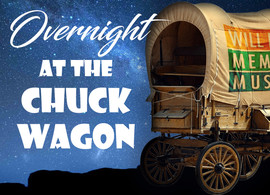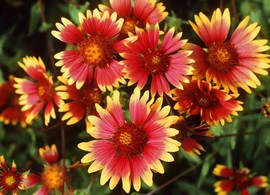|
On exhibit at the Oklahoma History Center
In Oklahoma City on July 4, 5, and 6, 1889, permission was granted by the US Department of the Interior for tribal citizens from the Darlington Agency to leave their reservations and take part in the first Fourth of July festivities held in Oklahoma City. Surprisingly, symbols of the American flag were a common design motif in clothing and items made by Indigenous peoples in the 1800s and early 1900s, even as their rights were not recognized by the US government. When Native nations were prohibited from performing their own traditions and religious ceremonies, they conducted their traditional practices during Fourth of July celebrations, and incorporated patriotic symbols into their clothing and other items to adapt to this practice. Eventually, American flags came to symbolize the service of family members in the US military.
This patriotic, beaded emblem of a bald eagle holding flags in its talons was made by Minnie Tohee (Iowa), the daughter of Chief Charles Tohee (Iowa) (1865–1930). It was made for Frank Craig Orner (1868–1942), a pioneer of Payne County who was a friend of the Iowa chief. The two men, from different worlds, lived and farmed in the same area of Perkins for four decades—where, in their later lives, they were both members of the Old Settler's Association of that area.
Charles Tohee was born in Nebraska in 1865. His Iowa tribal faction, which eventually became the Iowa Tribe of Oklahoma, was removed to the state of Oklahoma (then Indian Territory) in the 1870s. Tohee died on March 2, 1930 in his allotment home.
Frank Craig Orner came to Oklahoma via Kansas in 1889, staking a claim four miles west of Perkins. In addition to farming, he also worked as a one-time cowhand of the historic IOA Ranch of Texas, as a US marshal, and as a member of the 12th Oklahoma Legislature. He served on four excursions with the US Secret Service and as a US Scout in Indian Territory from 1891 to 1895. As a lifetime member of the Oklahoma Historical Society, Orner donated this vest along with other artifacts to the OHS collections in the 1930s. The vest can be seen on display in the ONEOK Gallery on the first floor of the Oklahoma History Center (03872, Frank C. Orner Collection, OHS).
Sources:
- Ancestry.com. Oklahoma and Indian Territory, Indian and Pioneer Historical Collection, 1937 [database on-line] (Provo, UT: Ancestry.com Operations, Inc., 2014), (1389-1399).
- Oklahoma Historical Society, “History of the Century Chest (1913–2013): Found in the Century Chest,” www.okhistory.org/centurychest/poster.
- Smithsonian National Museum of the American Indian, “Honoring the American Flag through Native Art,” YouTube, https://www.youtube.com/watch?v=WhrqET6hNHU.
- “Frank C. Orner: For the Legislature,” Stillwater Gazette, November 2, 1928.
- Gary Pratt, "Ioway Tribe History," Oklahoma Territorial Plaza Trust, www.okterritory.org/history.html.
-
Frank C. Orner, "Necrology: Memories of Chief Charles," The Chronicles of Oklahoma 8, no. 2 (June 1930): 241.
|
|

Let’s Talk About It: Cowboy Life
Pawnee Bill Ranch and Museum in Pawnee has partnered with Oklahoma Humanities (OH) to host OH’s book discussion series “Let’s Talk About It.” The meetings will take place as monthly in-person and online gatherings at the museum on Blue Hawk Peak, and will feature a different book title each month from July to November.
For the first meeting on Saturday, July 16, the featured title will be Cowboy Life: Reconstructing an American Myth (1975) by William W. Savage Jr., with scholar Dr. Karen Neurohr from Oklahoma State University.
All five of the books in the program have the overarching theme of the historical cowboy—the hired man on horseback who rode the ranges and trails of the post–Civil War West. The readings for this program may help to explain the primacy of the cowboy over all other western types from the 19th century. Each month, a scholar will give a 45-minute synopsis on the chosen book. After the synopsis, the scholar will lead an open forum discussion with the participants.
This program is free to the public. The museum will provide all the books, refreshments, and the venue. All participants need to bring is the desire to add to the discussion. The Pawnee Bill Ranch will have copies for purchase if participants wish to keep a copy of the books in the series. For more information, call 918-762-2513 or come by the museum to sign up for the program and take home the latest book in the “Let’s Talk About It” series. The Pawnee Bill Ranch and Museum is located at 1141 Pawnee Bill Road in Pawnee.
|
|
|
 Overnight at the Chuck Wagon
From Friday, July 8, at 5 p.m., to Saturday, July 9, at 9 a.m., children and their parents have a rare opportunity to stay overnight at the Will Rogers Memorial Museum.
Overnight at the Chuck Wagon participants will bed down in various parts of the museum for a night of 19th-century activities, movies, arts and crafts, games, and storytelling, with a chuck wagon dinner and breakfast provided.
Registration is required and is $45 for nonmembers and $35 for members. Space is limited, so call 918-341-0719 to see if there is room for another sleeping bag!
|
 Heritage Plants lecture at the Oklahoma History Center
On Saturday, July 16, from 1 to 3 p.m., the Oklahoma History Center (OHC) will offer a Heritage Plants lecture for ages 12 and up. After learning about Oklahoma’s native and heritage plants, participants will enjoy a tour of the beautiful flora of the OHC’s Red River Journey.
This program is free with paid admission to the OHC. It will take place in the Musser Learning Lab, located on the first floor inside the Research Center, and end in a walking tour. Call 405-522-0765 to learn more.
|
|
Sod House Museum quilting workshop on July 9
Visit the Sod House Museum southeast of Aline for a quilting workshop in air-conditioned comfort on Saturday, July 9. The workshop will take place from 9 to 11 a.m. with instructor Martha Ray.
The Sod House Museum seeks to preserve Oklahoma’s only remaining sod house, and interprets the early-day lifestyles of pioneers, from the establishment of the Cherokee Outlet in 1893 to 1920. The museum encloses the original sod house which is the key exhibit. Visitors can enjoy the experience of walking through the “soddy” and exploring exhibits, artifacts, photographs, and a root cellar.
The cost for the quilting workshop is $5 per person. For more information, please contact Director Renee Trindle at 580-463-2441 or sodhouse@okhistory.org.
|
|

Cows and Cowhands e-exhibit
The e-exhibit Cows and Cowhands, available through the Oklahoma Historical Society's online educational resources, traces the history of the cowboy. This useful web offering covers many aspects of cowboy life, including early roping techniques of the vaquero tradition, cattle ranching in Indian Territory, Black cowboys, and women in ranching. The material features the first-hand account of Johanna July (pictured right), a Black Seminole horse wrangler who used water to train horses as a young woman.
Learn how cattle drovers made the journey of 600 miles from the Texas plains to the railheads in Kansas, driving large cattle herds for national consumption. The journey could take 15 men up to three months to drive an average herd of 2,500 head of cattle.
The exhibit explores how cowboy work culture moved beyond the industry and influenced many other aspects of American life through Wild West Shows, live entertainment, sports, and movies. To see a full list of e-exhibits, click here. Looking for fun, educational tools this summer? To see online resources for students, educators, and families, click the button below.
|
|
|
OHS COVID-19 safety measures
We recommend that visitors who are not fully vaccinated against COVID-19 wear face masks in indoor public areas. We ask that you avoid visiting OHS museums, sites, and affiliates if you have COVID-19, are experiencing symptoms, have a fever, or are otherwise feeling sick or unwell.
|
|
|
Click event listings below for more information.
30 - Vintage Snack Sets exhibit closes, Fred and Addie Drummond Home, Hominy
1 - Early Influencers: How Anna Overholser & Henry Ione Overholser Perry Set the Style for Oklahoma City Women, 1903–1929 exhibit opens, Henry and Anna Overholser Mansion, Oklahoma City
2 - Pawnee Bill Cannon Dedication Ceremony, Pawnee Bill Ranch and Museum, Pawnee
2 - Guided tours, Honey Springs Battlefield, Checotah
2 - History Alive! on the Cherokee Strip, Cherokee Strip Regional Heritage Center, Enid
5 - Selections from In Citizen's Garb: Native Americans on the Southern Plains, 1889–1891 exhibit opens, Oklahoma History Center, Oklahoma City
5 - Barney P. Enright, Photographer exhibit opens, Cherokee Strip Museum and Rose Hill School, Perry
8 - Overnight at the Chuck Wagon, Will Rogers Memorial Museum, Claremore
9 - Oklahoma Route 66 Hall of Fame Induction Ceremony, Oklahoma Route 66 Museum, Clinton
9 - Route 66 Transitions, 1981–1991: Jerry McClanahan's First Decade of Route 66 Photography exhibit opens, Oklahoma Route 66 Museum, Clinton
9 - Quilting workshop with Martha Ray, Sod House Museum, Aline
9 - Market Basket workshop with Linda Lou Alexander, Fort Towson Historic Site, Fort Towson
12 - Tuesday Tunes featuring Hunter Thomas, Henry and Anna Overholser Mansion, Oklahoma City
16 - Will’s Cowboy Trader Days at the Ranch, Will Rogers Birthplace Ranch, Oologah
16 - Guided tours, Honey Springs Battlefield, Checotah
16 - Battle of Honey Springs Memorial Service, Honey Springs Battlefield, Checotah
16 - History Alive! on the Cherokee Strip, Cherokee Strip Regional Heritage Center, Enid
16 - Family Day at the Birthplace Ranch, Will Rogers Birthplace Ranch, Oologah
16 - Heritage Plants lecture, Oklahoma History Center, Oklahoma City
16 - Let’s Talk About It: Cowboy Life: Reconstructing an American Myth (1975) by William W. Savage Jr., Pawnee Bill Ranch and Museum, Pawnee
20 - Oklahoma Historical Society Executive Committee meeting, Oklahoma History Center, Oklahoma City
21 - Historic Preservation Review Committee meeting, Oklahoma History Center, Oklahoma City
21 - Thursday Night Lecture Series featuring Pawnee Bill Ranch’s Anna Davis, Will Rogers Memorial Museum, Claremore
23 - Guided tours, Honey Springs Battlefield, Checotah
26 - Oklahoma Summer Social Studies Conference, Oklahoma History Center, Oklahoma City
27 - Oklahoma Historical Society Board of Directors meeting, Oklahoma History Center, Oklahoma City
28 - National History Day Boot Camp (IN-PERSON and VIRTUAL), Oklahoma History Center, Oklahoma City
29 - Movie Night featuring Where the Red Fern Grows (1974), Will Rogers Memorial Museum, Claremore
|
|
|
Actor William Lawrence Boyd (right), perhaps best known for his role as the fictional cowboy Hopalong Cassidy, made 66 movies as that character. In the 1940s, Cassidy came to be associated with clean living and heroic deeds through hundreds of radio and television appearances. The long span of Boyd's career proves the attraction to the cowboy mystique for people who were smitten with Western living well into the sixties—and into the present day.
The metal lunchbox (left) with his likeness is one of over 2,000 items that were merchandised with the popularization of the Hopalong Cassidy character (2006.082, James E. Lee Collection, OHS / 2012.201.B0101.0341, Oklahoma Publishing Company Photography Collection, OHS).
|
|
|
|
|